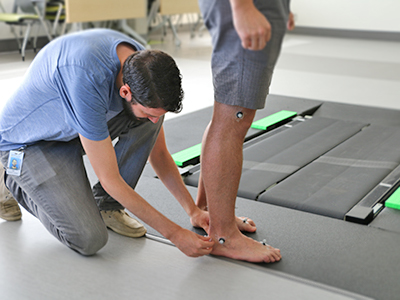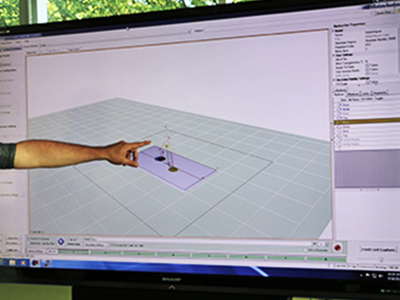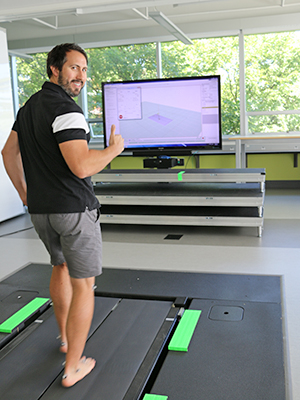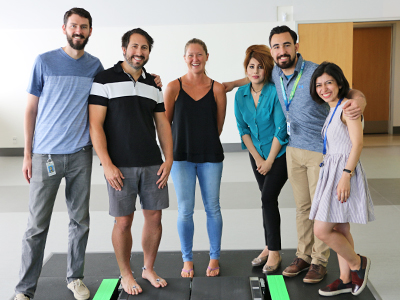
Looking into the future of mobility health in our aging society.
The Innovation to Implementation (i2i) lab at the Centre for Hip Health and Mobility (CHHM) supports cutting-edge, multidisciplinary mobility health research. Trainees of different specialties work collaboratively in this unique lab using its state-of-the-art equipment.
Thanks to its advanced technology, such as the Bertec split-belt treadmill and 3D motion capture studio, the lab is able to support a diverse range of research. Studies that take place here range range from understanding tendon function to how a hip injury affects mobility.

To use the treadmill and motion capture system, reflective markers are placed on participants in areas that will highlight their specific movements. Next, participants walk, run, squat, lunge or do other exercises on the treadmill—and special cameras placed throughout the lab pick up the motion of the reflective markers. Then, motion can be analysed to give trainees detailed mobility information, such as the participant’s speed, gait and force.

The research team says the futuristic equipment has the added bonus of making it fun and interesting to participate in studies. “Participants can see themselves and their movements on a screen, just like they would with a Wii video game, which makes it interactive,” says Dr. Charlie Waugh, a postdoctoral fellow at CHHM. “It is the same technology that was used to make Gollum from The Lord of the Rings movie—participants love it.”

Being in a study at the i2i lab is a unique experience that can be informative and engaging for participants. The studies often require more time than other types of research studies—in order to put on markers and do different exercises—and can take place over multiple sessions in order to measure progress. This gives participants a chance to learn about the process and develop a strong rapport with trainees.
“It’s not like a lot of labs in which, for example, participants come in, give a blood sample, and leave,” explains Maryam Mohtajeb, a Ph.D. student in orthopaedics. “They stay here for a while and ask questions. We spend time together. It’s such a great opportunity because we actually get to do something pretty unique with them.”
Participants in studies at CHHM are often older adults with mobility issues who have much to gain by taking part—such as learning how everyday movements like lunges, squats and walking are affected by their hip condition. “We get to know them over multiple sessions and see their progress—it’s great,” says Kip Squier, a masters student in rehabilitation sciences.
Angelo Graffos, also a masters student in rehabilitation sciences, agrees: “Our participants are the nicest people in the world. They’re so much fun to work with.”
“For a lot of our participants, their experience participating in research is actually really fun, really positive, and often very social. It’s great to be part of that.”
The positive participant experience is enhanced by the unique location of the lab, which is in a beautiful, large room overlooking the city. “So often, these types of labs are tucked away in a dark basement without windows,” explains Mohtajeb. “People actually want to be in our lab and spend time here because it’s bright and roomy, and has a beautiful view.” The lab is also used for social events, such as a recent fundraiser where professional dancers wore the reflective markers and their performance was projected onto the screen.
Future applications for the Bertec treadmill and motion capture system are still being developed—a clear indicator that innovative research will be coming out of the i2i lab long into the future.

To participate in a CHHM study, search for mobility-related studies at vchri.ca/participate.


